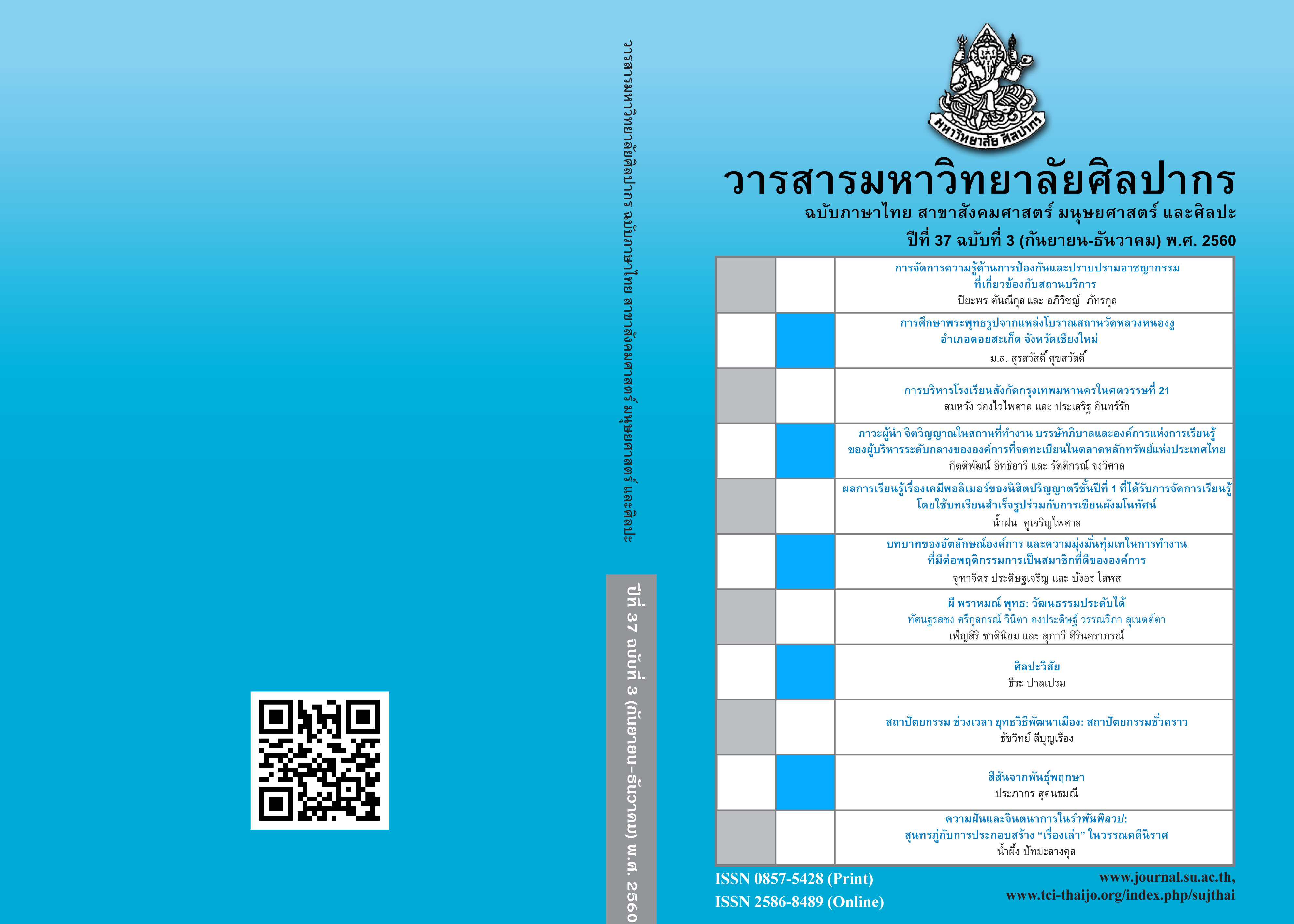ผี พราหมณ์ พุทธ : วัฒนธรรมประดับได้ (Spirit, Brahmanism, Buddhism: Cultural Adornment)
Main Article Content
Abstract
เครื่องราง” หรือ “เครื่องประดับ” เกิดขึ้นพร้อมกับมนุษย์ตั้งแต่ยุคก่อนประวัติศาสตร์ จากการเรียนรู้ในการอยู่ร่วมกันกับธรรมชาติ เป็นการจัดการกับ “สิ่งที่ไม่รู้” ให้กลายเป็น “สิ่งเหนือธรรมชาติ” ด้วยวัตถุที่มีผลต่อความเชื่อในด้านการปกป้องคุ้มครอง และสร้างระบบที่สอดคล้องกับการดำรงชีวิตอันเป็นสัญชาตญาณของมนุษย์เพื่อการรักษาเผ่าพันธุ์
ความกลัวต่อสิ่งเหนือธรรมชาติเหล่านี้เป็นที่มาของคติการนับถือ “ผี” ตามความเชื่อดั้งเดิมที่พัฒนาจากการเรียนรู้เกี่ยวกับตัวตนและจิตใจ และเชื่อมโยงกับแนวคิดเรื่องผู้ปกป้องคุ้มครอง บรรพบุรุษ และการตั้งถิ่นฐานบ้านเรือน
การเผยแพร่เข้ามาของศาสนาพุทธและศาสนาพราหมณ์หรือฮินดูในเวลาต่อมา พร้อมกับคติการสร้างรูปเคารพและวัตถุมงคล เปลี่ยนแปลงทัศนคติในการดำเนินชีวิตของมนุษย์ไปสู่ระบบระเบียบของความดีงาม โดยเน้นการบูชาเพื่อการปกป้องคุ้มครองและสร้างความเป็นศิริมงคล ทั้งต่อพื้นที่ในอุดมคติ พื้นที่ทางกายภาพ และพื้นที่บนร่างกายมนุษย์
งานสร้างสรรค์เครื่องประดับในโครงการวิจัยนี้นำเสนอเครื่องประดับจำนวน 4 ชุด อันมีพื้นฐานจากคติความเชื่อที่หล่อหลอมให้เกิดอารยธรรมไทย โดยแสดงออกผ่านเครื่องประดับที่เชื่อมโยงแนวคิดเรื่องพิธีกรรมและวัตถุ ตลอดจนสร้างองค์ความรู้อันสัมพันธ์กับความเป็นมาทางประวัติศาสตร์ที่ขับเคลื่อนด้วยความเชื่อและศาสนา รวมทั้งความสัมพันธ์ระหว่างรูปแบบกาลเวลา และวิถีชีวิตของมนุษย์ในสังคมร่วมสมัย
“เครื่องประดับชุดแรก” สะท้อนการเชื่อมโยงร่างกายกับสัญชาตญาณ เป็นพื้นฐานของการสักการะร่างกายและความรู้สึกตามธรรมชาติ โดยการแสดงสภาวะของขนาดและปริมาณที่มีลักษณะพิเศษ เพื่อสื่อสารความกลัว ความทุกข์และความเชื่อที่เกิดขึ้นภายในจิตใจ
เมื่อสังคมมนุษย์เปิดรับแบบแผนของพิธีกรรมและการสักการะอันมีต้นแบบจากอารยธรรมอินเดียโบราณ การนับถือเทพเจ้า บุคลาธิษฐาน การถือวรรณะ ตลอดจนการแบ่งแยกความดีและความชั่ว ล้วนเป็นการจัดระเบียบทางความคิดและสัญชาตญาณมนุษย์ให้สอดคล้องกับกรอบของศีลธรรม “เครื่องประดับในชุดที่ 2” จึงตีความเรื่องราวของความสอดคล้องดังกล่าว โดยได้แรงบันดาลใจจากพิธีกรรมการไหว้ครูโขน สร้างสรรค์เป็นผลงานที่แสดงความนอบน้อมต่อร่างกายและจิตใจ ด้วยการเคลื่อนไหวร่างกายอย่างสมดุล
อย่างไรก็ตาม แม้ว่าหัวใจของพุทธศาสนาจะมุ่งสอนเรื่องความว่างของจิต การหลุดพ้น และการไม่สะสมในวัตถุทางกาย แต่ก็ไม่อาจปฏิเสธคุณค่าของเครื่องประดับและวัตถุมงคลในอุบายที่ส่งเสริมศีลธรรมอันเป็นแนวคิดคู่ขนาน “เครื่องประดับในชุดที่ 3” ย่อมสะท้อนการหลุดพ้นด้วยตนเองและความต้องการสิ่งพึ่งพิง ซึ่งนำไปสู่การปรากฏหรือไม่ปรากฏรูปธรรมของวัตถุเหล่านั้น อันแสดงถึงความสอดคล้องแต่ก็มีความขัดแย้งในตัวมนุษย์
ทั้งนี้ความสัมพันธ์ของเครื่องประดับและความเชื่อในจิตใจมนุษย์มิได้เปลี่ยนแปลงไปมากนักจากอดีต ดังจะเห็นได้จากสถานะและรูปแบบของ “เครื่องประดับในชุดสุดท้าย” ซึ่งอธิบายปรากฏการณ์ทางความเชื่อของสังคมไทยในปัจจุบัน ที่เน้นย้ำว่าความกลัว ความทุกข์ และความอยาก เป็นส่วนหนึ่งที่ฝังรากในจิตใจมนุษย์โดยยากจะคลี่คลาย
“Talisman” or “jewellery” has existed since the pre-historic period as a result of human’s learning to live with nature. Human turned the ‘unknown’ into ‘superstition,’ using objects which were believed to power to protect and creating a system that corresponds to their way of living, a human instinct to maintain their race.
The fear of supernatural power was the origin of animism derived from traditional beliefs about self and mind and connected to the ideas of protectors, ancestors and settlement.
The arrival of Buddhism, Brahman and Hinduism came with the tradition of idolatry. This turned the attitude towards living into a ritual and disciplined one. The emphasis of worshipping were for the sense of protection and auspiciousness in the aspects of idealism, physical space and human body.
This research project presents four sets of jewellery which are created based on the traditional Thai beliefs. Each piece of jewellery reflects the connection between an object and rituals behind it. It also contributes new knowledge of how historical background was driven by beliefs and religion and the relationship between time and contemporary life.
“The first set of jewellery” reflects the relationship between human body and human instinct. It is the basis of body worshipping and raw emotions. It is presented through the size and volume in order to reflect the fear, suffering and belief inside.
Through the influence of ancient Indian culture, human society adopted the tradition of rituals, worshipping. Worshipping of gods, personification, caste systems, and the ideas of ‘good’ and ‘bad’ were formed as a way to conform human thoughts and instinct to the moral and ethical thinking frame. “The second set of jewellery” interprets this connection. It is inspired by the ritual of paying respect to Khon masters. It portrays the humility of body and mind demonstrated through composed movements.
While the essence of Buddhism is about non-attachment, liberation and abstention from material accumulation, the hidden value of jewellery and talisman as a scheme to promote morality cannot be denied even though they seemed parallel to each other. “The third set of jewellery” hence reflects the perseverance to be free from the circle of life by oneself and having a sacred object to hold on to. This leads to the physical and non-physical appearance of the objects which symbolizes the harmony and conflict in every human being.
The relationship between a piece of jewellery and human mind has not changed substantially from the past as demonstrated through “the finale set of jewellery”. It explains phenomenon of modern day belief of Thai society which reinforces the message that fear, suffering and desire are deep-rooted in human mind and cannot be easily disentangled.
Downloads
Article Details
References
Oceansmile (2014). Pha Tam. Retrieved on January 3, 2014, from http://www.oceansmile.com/E/Ubon /patam.htm.
Paul, L., & Elaine, L. (1998). Peoples of the Golden Triangle. UK: Thames and Hudson.Sujit, W. (2004). Tribes and Ethnics Groups in Suvarnabhumi, Ancestor of the Thais (ชาติพันธุ์สุวรรณภูมิ บรรพชนคนไทยในอุษาคเนย์). Bangkok:Matichon Publishing House.
Suraporn, A. (2014). Guru Tradition Ceremony. Retrieved on January 22, 2014, from http://www.news.rmutt.ac.th/archives/category/english-version
Tanitsak, U. (2008). The Research on the Participation of Cultural and Community Networks in the Conservative Treat Ceremonial the Ancestor Ghost; Chao Kaloeng, Tambon Kamtoey, Amphur Muang, Changwat Nakhon Phanom (รายงานการวิจัย การมีส่วนร่วมของเครือข่ายวัฒนธรรม และชุมชนในการอนุรักษ์พิธีกรรมเลี้ยงผีปู่ตาชาวกะเลิง ตำบลคำเตย อำเภอเมือง จังหวัดนครพนม). Nakhon Phanom: the Office of Nakhon Phanom Culture.
Vidya, D. (2009). The Body Adorned. Singapore: Columbia University Press.


